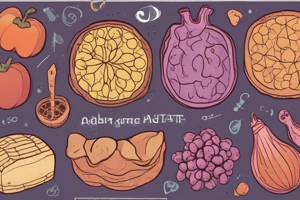Podcast
Questions and Answers
What is the change in rotation of polarized light called when D-glucose is crystallized?
What is the change in rotation of polarized light called when D-glucose is crystallized?
- Esterification
- Mutarotation (correct)
- Glycosidation
- Reduction
What type of sugar is formed when oxygen is removed from the (OH) group?
What type of sugar is formed when oxygen is removed from the (OH) group?
- Glycoside
- Sugar acid
- Amino sugar
- Deoxy sugar (correct)
What is the result of reacting (OH) of the anomeric carbon of a monosaccharide with an alcohol?
What is the result of reacting (OH) of the anomeric carbon of a monosaccharide with an alcohol?
- Sugar phosphate formation
- Sugar acid formation
- Deoxy sugar formation
- O-glycoside linkage formation (correct)
What is the biological importance of sugar phosphates?
What is the biological importance of sugar phosphates?
What is the product of oxidizing glucose with Cu++?
What is the product of oxidizing glucose with Cu++?
What is the reducing agent used to form sugar alcohols?
What is the reducing agent used to form sugar alcohols?
What is the importance of mannitol in microbiology?
What is the importance of mannitol in microbiology?
What is the product of reducing fructose?
What is the product of reducing fructose?
What is the primary form of existence for monosaccharides with 5 or more carbons in solution?
What is the primary form of existence for monosaccharides with 5 or more carbons in solution?
What is the term for the asymmetric carbon in a sugar molecule?
What is the term for the asymmetric carbon in a sugar molecule?
What is the type of linkage formed between an aldehyde group and an alcohol group on the 5th carbon atom?
What is the type of linkage formed between an aldehyde group and an alcohol group on the 5th carbon atom?
What is the primary difference between α-D-glucopyranose and β-D-glucopyranose?
What is the primary difference between α-D-glucopyranose and β-D-glucopyranose?
What is the term for the process of rotating from one anomeric form to another?
What is the term for the process of rotating from one anomeric form to another?
What is the typical ring form of glucose in biological systems?
What is the typical ring form of glucose in biological systems?
What is the term for the binding of a keto group with a alcohol (hydroxyl group) of the 5th carbon atom?
What is the term for the binding of a keto group with a alcohol (hydroxyl group) of the 5th carbon atom?
What is the objective of knowing the clinical importance of mannitol and sorbitol?
What is the objective of knowing the clinical importance of mannitol and sorbitol?
Flashcards are hidden until you start studying
Study Notes
Cyclization of Monosaccharides
- Monosaccharides with 5 or more carbons exist mainly in a ring (cyclic) form, with less than 1% in the open-chain (acyclic) form.
- The aldehyde group reacts with an alcohol group on the 5th carbon atom to form a pyranose ring, or the keto group reacts with an alcohol group to form a furanose ring.
- The carbonyl carbon (anomeric carbon) is asymmetric, and glucose exists as a pyranose ring, while fructose exists as a furanose ring.
Hemiacetal and Hemiketal Linkages
- Hemiacetal linkage is the binding of an aldehyde with a hydroxyl group on the 5th carbon atom.
- Hemiketal linkage is the binding of a keto group with a hydroxyl group on the 5th carbon atom.
Anomers and Mutarotation
- Anomers are monosaccharides that differ in the configuration of the OH group on the anomeric carbon.
- Examples of anomers are α-D-glucopyranose and β-D-glucopyranose.
- Mutarotation is the change in specific rotation of polarized light with time, due to a slow change of the α form of sugar to its β form, reaching an equilibrium mixture.
Monosaccharide Derivatives
- Amino sugars: amino groups substitute for hydroxyl groups of sugars, forming amino sugars.
- Glycosides: O-glycoside linkage is formed when (OH) of the anomeric carbon reacts with an alcohol.
- Sugar phosphates: (OH) groups of sugars are esterified to form sugar phosphates, which are biologically important in glucose metabolism.
- Deoxy sugars: oxygen is removed from the (OH) group to form deoxy sugars, such as deoxyribose, which is part of nucleic acid (DNA).
- Sugar acids: oxidation of glucose forms gluconic acid, used to detect glucose in urine (glucosuria) and follow-up of diabetes mellitus.
- Sugar alcohols: reduction of sugars with hydrogen forms sugar alcohols, such as sorbitol and mannitol, which are important in identifying bacterial colonies.
Clinical Importance of Mannitol and Sorbitol
- Mannitol is used to identify bacterial colonies.
- Sorbitol is formed from glucose reduction and is important in glucose metabolism.
Studying That Suits You
Use AI to generate personalized quizzes and flashcards to suit your learning preferences.



